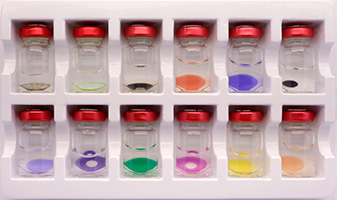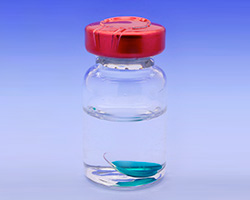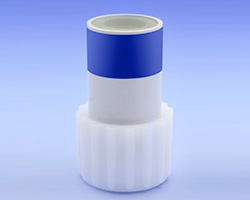A tinting system that allows the contact lens laboratory to produce enhancement tints in-house on any hydrophilic materials ranging from 38% HEMA to any high water content material. The tints used are unaffected by all contact lens solution currently available world-wide including peroxide, chlorine and enzymatic cleaning systems.
Lenses may also be autoclaved repeatedly after tinting without adverse effect.
The dye is supplied as a solution, so there is no weighing out of dye powders to be done. The simple spring loaded jigs are easy to use and the silicone rubber masks ensures that there is no damage caused to the lens surface.
When applied to the lens the dye enters the surface pores, and when treated with the developing agents, the colour required appears and the dye is locked into the lens surface. Once developed, the colours are completely permanent and stable to all forms of lens care treatment.
There are two concentrations of dye, one for HEMA and one for high water content lenses; both dyes work without pre-swelling the lenses as required by other tinting systems. All the dyes are single colours, i.e.: the green dye is not a mixture of blue and yellow dyes as with other systems. This produces consistent colours across the range of hydrophilic materials.



If you are looking for an easy, safe and fast method to tint finished soft contact lenses, then our Spectratint Tiinting System is all you need. We have the solution to existing users of the now obsolete Softchrome tinting system.
The tints used are unaffected by all contact lens solution currently available world-wide, including peroxide, chlorine and enzymatic cleaning systems. Lenses may also be autoclaved repeatedly after tinting without adverse effect.
The dye is supplied as a solution, so there is no weighing out of dye powders to be done. The simple spring loaded jigs are easy to use and the silicone rubber masks ensures that there is no damage caused to the lens surface.
When applied to the lens, the dye enters the surface pores, and when treated with the developing agents, the colour required appears and the dye is locked into the lens surface. Once developed, the colours are completely permanent and stable to all forms of lens care treatment.
What kind of dyes are used in Spectratint?
Spectratint uses a range of dyes that have been tested for efficacy and durability over many years and allow a simple, quick method for enhancement tinting.
How long do the dyes and solutions last?
The dyes and solutions are safe to use for at least three to six months To ensure maximum life of the dyes, the bottles should be kept in a cool dark place.
What are the activator and developer?
The activator used is completely stable and requires no special conditions. The developer is sensitive to prolonged periods of exposure to air, although the time taken for any change should be measured in days rather than hours.
How many lenses can I tint from a bottle of dye?
Spectratint dyes are supplied in easy to use convenient glass vials. Each vial contains 10ml of dye and is enough to tine more than 20 lenses of consistent quality.
Is it possible to remove the dye from a tinted lens?
Once developed and autoclaved, the dyes are permanently locked into the lens surface and are completely stable to all forms of lens care products including peroxide systems.
How many colours can I produce from the Spectratint system?
A large range of dyes is supplied with the system and customized colours can be achieved by experimentation with timing. By combining different dyes, any individual colour can be achieved. With this system, it is possible to produce a unique range of tints.
Can the colour intensity vary from lens to lens?
The intensity of the colour is dependent on the time the lens is left in contact with the dye. The thickness of lenses or varying water contents have no effect on the final product.
Does the tint last longer in low water lenses?
The tint is consistent in all types of lenses. All tinted lenses show some fading over a period of time, but with modern replacement schemes, most lenses are replaced before any noticeable fading occurs.
Can the Spectratint system be used with torics?
Yes. It also possible to tint high plus or high minus lenses successfully.
Increase profits by tinting in-house. 16 subtle tint colours or blend then to create unique custom colours
Simple easy process
Almost zero reject rate
Advanced masking system ensures no lens damage
Low process cost
No colour separation when autoclaving
The tint is bound irreversibly into the lenses
Blend unique custom colours
Colour consistency in any soft lens material
Complete control of tint density
Fully occluded pupils